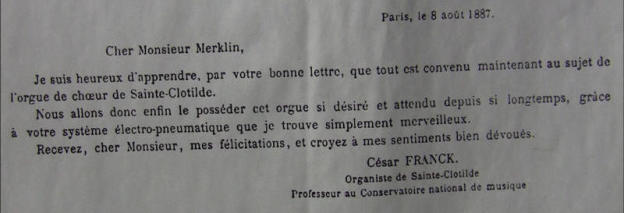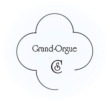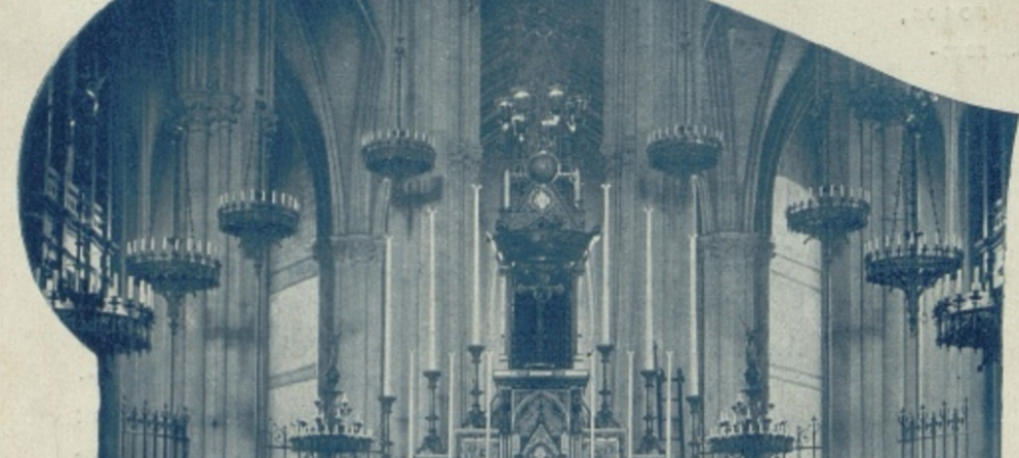THE CHOIR ORGAN
COMPOSITION 1933
Until 1888, there was no choir pipe-organ at Ste. Clotilde due to placement
difficulties (1,2). However, in 1861, a Mustel harmonium was bought to serve as
choir organ (3).
The new electro-pneumatic system of Schmœle & Mols used by Merklin offered
the posibility to install an organ using opposite sides of the choir. In a letter to
Merklin, Cesar Franck wrote in 1887 (see picture of the letter below): ... nous allons
donc enfin le posséder cet orgue si désiré et attendu depuis si longtemps, grâce à
votre système électro-pmeumatique, que je trouve simplement merveilleux.
Thus, a choir organ was ordered and made by Merklin, inaugurated on February
20, 1888 (14 stops). A novelty in Paris! The organists who examined and approved
the instrument included Franck, Dubois, Samuel Rousseau and Verschneider. The
committee reported: An organ of electro-pneumatic design has just been
installed in one of the leading churches in Paris. This is a historic event in organ
building, because of the resources afforded by the system which the builders
employed. It would be a mistake to expect Ste Clotilde being a replica of the
design essayed about twenty years ago by the late Barker. (4)
The console was situated among the choir pews, at some distance from the
pipes, which were placed on either side of the chancel; the wind supply was
hidden behind the altar. The console was located between the stalls of the choir
(Evangile side) and the food was hidden behind the main Altar. The pipes were
housed in two neo-Gothic buffets that were located under the arches of the choir,
above the entrance gates (even today, you can see traces of the frame of the
buffets in the pillars). In the 1930s, women were allowed to come and sing in the
choir. At that time, it was unthinkable to see the female population near the
sanctuary. The singers, who had previously sung in the choir, were relegated to
the first tribune where an accompanying organ was built. As a result, the choir
organ (whose operation was becoming increasingly precarious) was dismantled
in 1935.
To read: an article on the choir organ published in La Musique Sacrée, in 1902.
THE TRANSFER OF THE OLD CHOIR
ORGAN
This organ was dismantled in 1935 and then installed and enlarged by the house Cavaillé-Coll for the Parisian living room of the Marquis de Froissart. He was a big shareholder and financial of the house Cavaillé-Coll. The Swell became Positif expressive and a great symphonic Swell was added. A big three-keyboard-console replaced that of Merklin. To realize this enlargement, the organ of Azans was used. This organ had been bought in 1923 by Marquis de Froissard from the catalogue of Mutin (2-keyboard organ, incorporating parts of a 17th century organ case) for the church of Azans. In 1948, this organ was given to the parish Saint Léon in Paris XV. It was put together by Jules Isambart. The keyboard of grand- organ lost its expression. On this same keyboard, a new Salicional replaced the Clarinet, that was transferred to the Positif, replacing the Voix Humaine. This last stop was not reinstalled.Since then, Dargassies has restored this instrument. A new electro-pneumatic traction was installed and the transmissions as well as the stop traction were renewed. The composition has been preserved, only the Swell was reinforced and the foundation stops were made more ascending. (source: Bernard Dargassies, 2018, Victor Weller, 2019)THE FORMER CHOIR ORGAN
(1) According to Fenner Douglas (1980, p. 1410, 1999, p 151) Cavaillé-Coll placed - in attendance of the great organ - a temporary choir organ of four stops in 1857, replaced in 1858 by an instrument of 14 stops on
the provisional organ tribune.
(2) According to Ann Labounsky (based on a personal letter to her by Pierre Cogen) there was originally a harmonium with pedals on the choir loft; the bass line was supplied by a string double bass.
(3) According to Rollin Smith (Playing the Organ Works of Cesar Franck, page 43)
(4) The older system of Barker was used in e.g. St Augustin
Sources:
•
Fennar Douglass Cavaillé-Coll and the musicians Raleigh 1980
•
Fenner Douglas Cavaillé-Coll and the French Romantic Tradition. Yale University Press New Haven and London, 1999.
•
Ann Labounsky Jean Langlais The man and his music Amadeus Press, Portland, Oregon, 2000. ISBN 1-57467-054-9
•
Carolyn Shuster Fournier Les instruments à claviers d'accompagnement de la basilique Sainte-Clotilde La tradition musicale de la basilique Sainte-Clotilde de Paris L’Orgue n° 278-279 (2007/II-III) 159-161 ISSN
0030-5170
•
Orgues de L'Ile de France Tome 5 Klinksieck, Paris, 1992 ISBN 2-252-02848-3, 2-252-02941-2 2-252-03121-2
•
Orpha Ochse Organists and Organ playing in nineteenth-century France and Belgium (;age 100) Indiana University Press Bloomington & Indianapolis 2000.
•
Rollin Smith Playing the Organ Works of Cesar Franck Stuyvesant, N.Y.: Pendragon Press, 1997
Victor Weller Recherches aux archives de la ville de Paris et du diocèse (Printemps 2019)

‘L'ORGUE D’ACCOMPAGNEMENT’
After much discussions, it was decided in 1936 to construct the current
accompaniment organ, despite the unfavourable opinion of Charles
Tournemire. Its construction was entrusted to the House Cavaillé-Coll-Pleyel.
Dedicated to accompaniment, it was then decided to place it in a niche on the
first tribune (previously reserved for instrumentalists),under the great organ.
This unprecedented situation explains the fact that it has no buffet (only an
expressive box). The console is placed against the organ and is typical for
Mutin-Pleyel.
In 1965, J. Picaud did some small works at the request of François Tricot:
•
transfer of the Doublette from the Swell to the GO and the Nasard from GO
to the Swell
•
transformation of Basson-Hautbois 8' of the Swell into Trumpet 8'
Used very regularly by François Tricot until 1987, the instrument is used today
only when there are maintenance works on the Great Organ.





on the left: a drawing of the former choir organ
on the right: the two organ cases of the former choir organ
THE CHOIR ORGAN
THE FORMER CHOIR ORGAN
Until 1888, there was no choir pipe-organ at
Ste. Clotilde due to placement difficulties (1,2).
However, in 1861, a Mustel harmonium was
bought to serve as choir organ (3).
The new electro-pneumatic system of
Schmœle & Mols used by Merklin offered the
posibility to install an organ using opposite
sides of the choir. In a letter to Merklin, Cesar
Franck wrote in 1887 (see picture of the letter
below): ... nous allons donc enfin le posséder
cet orgue si désiré et attendu depuis si
longtemps, grâce à votre système électro-
pmeumatique, que je trouve simplement
merveilleux.
Thus, a choir organ was ordered and made by
Merklin, inaugurated on February 20, 1888 (14
stops). A novelty in Paris! The organists who
examined and approved the instrument
included Franck, Dubois, Samuel Rousseau
and Verschneider. The committee reported: An
organ of electro-pneumatic design has just
been installed in one of the leading churches
in Paris. This is a historic event in organ
building, because of the resources afforded by
the system which the builders employed. It
would be a mistake to expect Ste Clotilde
being a replica of the design essayed about
twenty years ago by the late Barker. (4)
The console was situated among the choir
pews, at some distance from the pipes, which
were placed on either side of the chancel; the
wind supply was hidden behind the altar. The
console was located between the stalls of the
choir (Evangile side) and the food was hidden
behind the main Altar. The pipes were housed
in two neo-Gothic buffets that were located
under the arches of the choir, above the
entrance gates (even today, you can see traces
of the frame of the buffets in the pillars). In the
1930s, women were allowed to come and sing
in the choir. At that time, it was unthinkable to
see the female population near the sanctuary.
The singers, who had previously sung in the
choir, were relegated to the first tribune where
an accompanying organ was built. As a result,
the choir organ (whose operation was
becoming increasingly precarious) was
dismantled in 1935.
To read: an article on the choir organ published
in La Musique Sacrée, in 1902.
‘L'ORGUE D’ACCOMPAGNEMENT’
After much discussions, it was decided in 1936
to construct the current accompaniment
organ, despite the unfavourable opinion of
Charles Tournemire. Its construction was
entrusted to the House Cavaillé-Coll-Pleyel.
Dedicated to accompaniment, it was then
decided to place it in a niche on the first
tribune (previously reserved for
instrumentalists),under the great organ. This
unprecedented situation explains the fact
that it has no buffet (only an expressive box).
The console is placed against the organ and
is typical for Mutin-Pleyel.
In 1965, J. Picaud did some small works at the
request of François Tricot:
•
transfer of the Doublette from the Swell to
the GO and the Nasard from GO to the
Swell
•
transformation of Basson-Hautbois 8' of
the Swell into Trumpet 8'
Used very regularly by François Tricot until
1987, the instrument is used today only when
there are maintenance works on the Great
Organ.

More information on the desktop-version



















